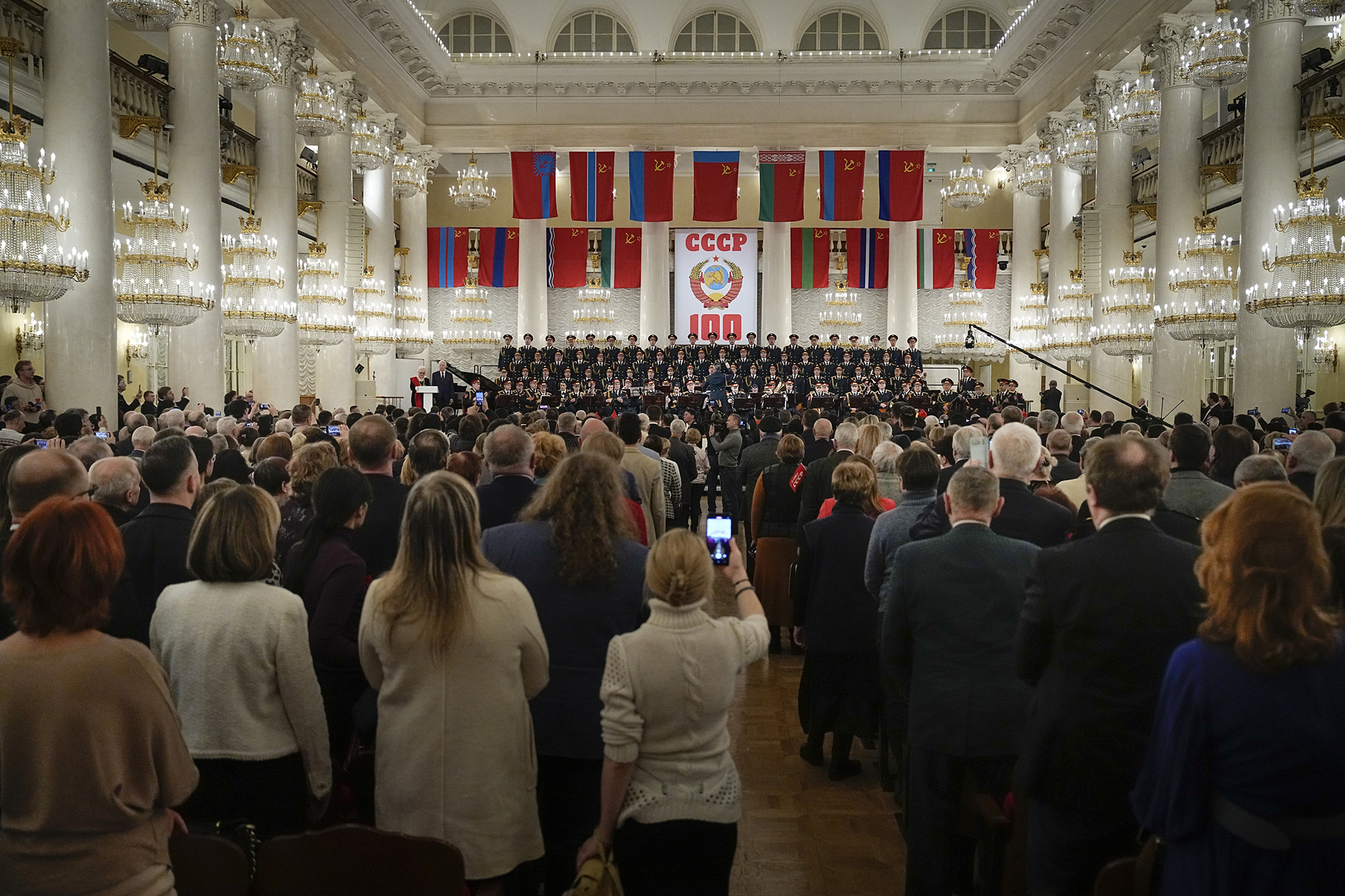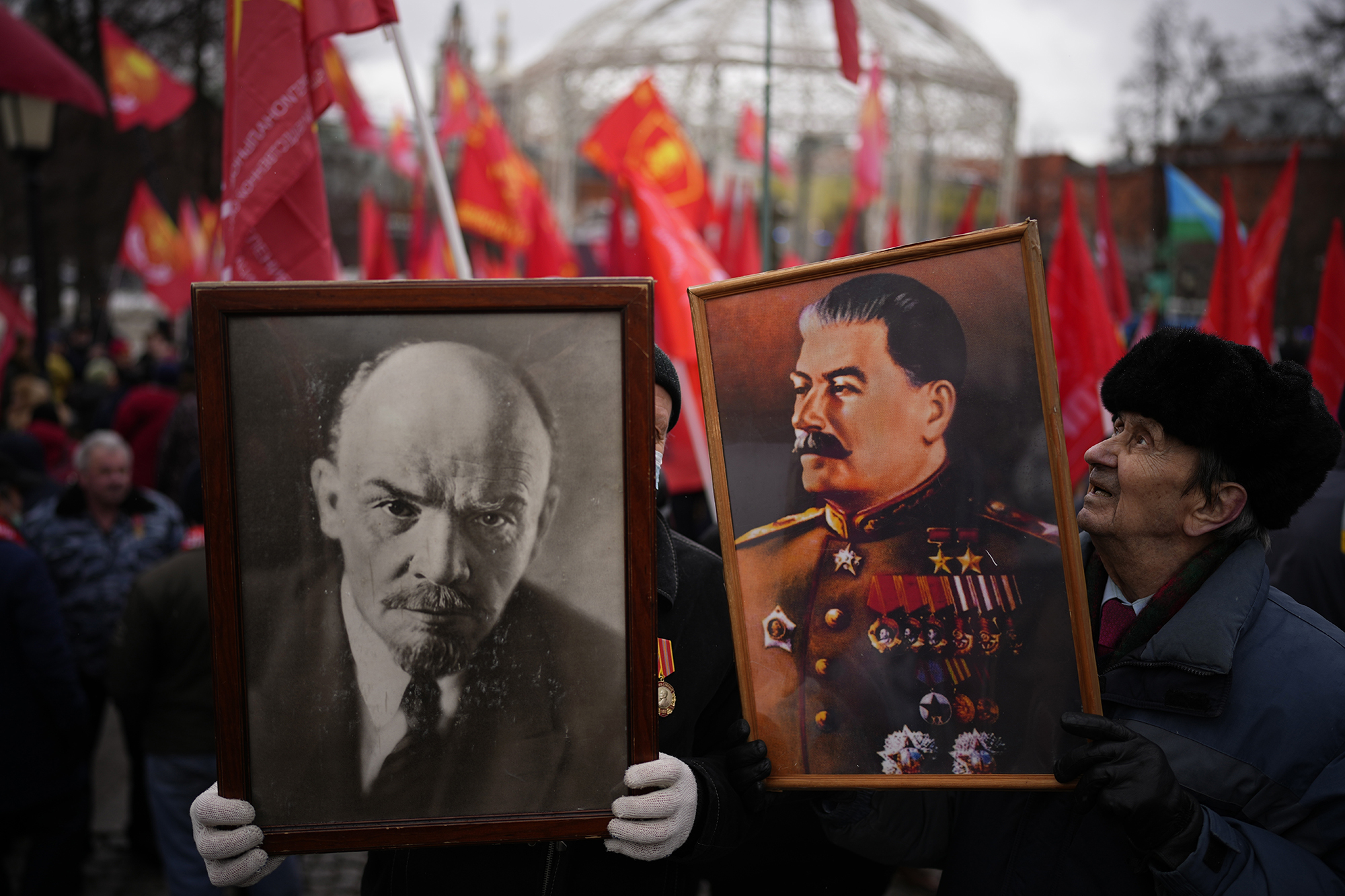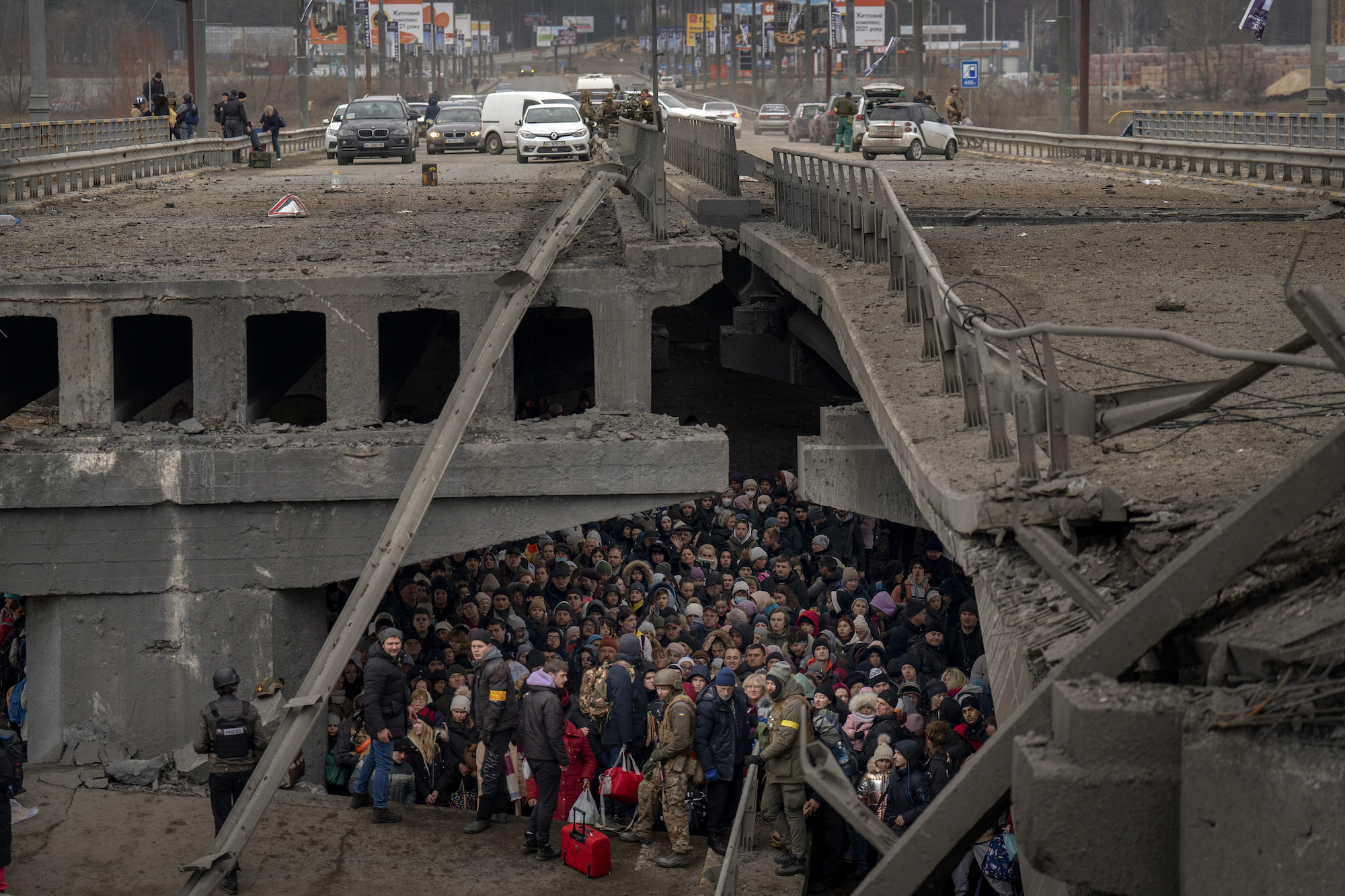
On Dec. 30, 1922, representatives of the Soviet governments of Russia, Ukraine, Belarus, and the Transcaucasian Republic (encompassing Armenia, Azerbaijan, and Georgia), announced the formation of a new country: the Union of Soviet Socialist Republics, the first nation in the world based on Marxist socialism.
“By the time the USSR turned 50, in 1972, it was recognized as a global superpower, matching or exceeding the military strength of its only rival, the United States,” says Benjamin Nathans, a history professor in the School of Arts & Sciences. “The Communist Party organized grand celebrations in Moscow that year. Hardly anyone inside or outside the country imagined that it would not live to mark its centenary in 2022.”
To mark what would have been the 100th anniversary of the Soviet Union, Penn Today reached out to six experts from three Penn schools for their thoughts. They discuss the current situation in Russia and the war in Ukraine, Vladimir Putin’s approach to history, and the USSR’s role in advancing rights.
Philip M. Nichols, Wharton School and the Russia and East European Studies program in the School of Arts & Sciences
The Soviet Union was born in times that might seem familiar. Disruptive technological, political, and cultural changes left populations reeling and without hope. The Soviet Union offered an alternative. Rather than tinkering with skewed political, financial, and market systems, the Soviet alternative proposed torching those systems and building something new. Every person would have a voice in decisions through a pyramid of councils, or “soviets” in Russian, and those decisions would include directing the use of resources in production, distribution, and consumption. Millions of people around the world cheered this alternative, even as the horrible abuses and cruelties of the Soviet system became known.
I recently returned from Ukraine. During countless hours in air raid shelters, Ukrainians shared their thoughts about the current Russian invasion and invasions by empires gone by. No one ascribed the current invasion to a rebirth of the Soviet empire. In frequent trips to Russia, virtually no one has expressed a desire to abandon their private property and rekindle the Soviet system. Even the mercurial President Putin has said that “anyone who wants it restored has no brains.” Russia’s invasion of Ukraine harkens instead to the empire-building mindsets that pervaded Europe when the Soviet Union was born, a reversion that threatens prosperity and well-being throughout the world.
The birth of the Soviet Union, nonetheless, offers a powerful reminder. Ukrainians understandably focus on the imperialist threat, but in the past few months I have also talked with ordinary people throughout Eastern Europe, southern Africa, and Southeast Asia. Business can create prosperity, but everywhere I hear rumblings that things are not quite right, that ordinary people do not benefit from the disruptive changes now rocking our world. Looking back on the birth of the Soviet Union should remind business firms and market actors that they only exist because society allows them to exist, and society might revoke its permission if systems do not contribute to the well-being of everyone.
Kristen R. Ghodsee, School of Arts & Sciences
For the greater part of the 20th century, the USSR represented an existential threat to the West. Despite the suffering of many Soviet citizens, the establishment of the world’s first workers’ state proved a great boon to Western workers, racial minorities, and women, catalyzing social progress that wouldn’t have happened otherwise.
Two years after the 1917 revolution, fearful Western politicians agreed to the creation of the International Labor Organization (ILO), a tripartite organization that would bring together governments, employers, and workers to address growing global labor unrest. The historian Sandrine Kott argues that the ILO was created specifically to prevent communist revolutions and that after World War II superpower tensions forced Western employers to make many concessions to labor activists. Similarly, the historian Mary Dudziak has demonstrated how persistent Soviet grandstanding about America’s poor treatment of its Black minority population helped to catalyze the civil rights movement.
In my own work, I’ve explored how Soviet commitments to women’s emancipation pressured American leaders to invest resources in, and expand privileges to, women in the United States.
Consider the National Defense Education Act (NDEA) of 1958: After the 1957 launch of the Sputnik satellite, American leaders panicked. They feared they were losing the space race because of a lack of trained personnel in science and mathematics, partially as a result of Soviet investments in the capabilities of its women. A 1957 government report on “Womanpower” had noted that “there are annually some 13,000 women graduating as engineers in the Soviet Union, compared to well under 100 in the United States.”
The NDEA infused more than a billion dollars into federal programs, including those to support the education and training of young American women in what we now call STEM fields. According to historian Ruth Rosen, “to contain Communism, the nation suddenly needed women in the laboratory more than at home.”
Also consider the 1972 passage of Title IX, a comprehensive federal law prohibiting discrimination on the basis of sex in any federally funded education program or activity. The historian Susan Ware directly attributed sudden government interest in preventing sex discrimination to the Soviet domination of the Olympics medal count: “If the United States was going to hold its own against Soviet athletes in the medal race, it needed the contributions of well-trained female athletes in addition to those of its men.” Title IX also coincided with the slow move toward co-education at elite U.S. universities and the creation of many new professional opportunities for women.
The NDEA and Title IX were policies inspired directly by the Cold War context of superpower rivalry. With the collapse of the USSR in 1991, the U.S. no longer had an ideological foil that championed women’s rights, and continued progress has stalled.
Benjamin Nathans, School of Arts & Sciences
The Bolsheviks came to power in Russia in October 1917, but it took five years and a civil war to formally establish the Union of Soviet Socialist Republics, the “experimental motherland” for which they would become known around the world. As with many new ventures, most people assumed it wouldn’t last. It did last, for nearly seven decades—roughly a human lifespan. That seems like a relatively brief existence for a sovereign state, but for a revolutionary polity it is unusually long. History is littered with short-lived revolutions.
By the time the USSR turned 50, in 1972, it was recognized as a global superpower, matching or exceeding the military strength of its only rival, the United States. The Communist Party organized grand celebrations in Moscow that year. Hardly anyone inside or outside the country imagined that it would not live to mark its centenary in 2022. Russians have seen no commemorations of that anniversary this year, a year overshadowed by Vladimir Putin’s war of conquest against Ukraine. Putin famously called the collapse of the Soviet Union in 1991 “the greatest geopolitical catastrophe of the 20th century,” but the legacy of the USSR is, in fact, a source of profound ambivalence for him and the Russian political elite.
In 2017, the Kremlin gave the impression of not knowing what to do about the centenary of the Bolshevik revolution, an event that catapulted Russia into a new era of world-historical significance but also laid waste to traditional ways of life and brought unfathomable suffering to tens of millions of people. One of the many ways Putin expresses his contempt for Ukraine is to dismiss it as an artificial creation of the USSR’s founding father, Vladimir Lenin.
A man seemingly obsessed with history, Putin invoked the USSR’s epic victory over Nazism in 1945 to justify his attack on alleged Nazis in Ukraine, but he prefers to compare himself not to Stalin but to 18th-century czars such as Peter the Great and Catherine the Great, who extended the borders of Russia’s empire into Europe. The Soviet era is being absorbed into a longer history of what Putin likes to call “the Russian world,” a world separate from the West, with its own exceptional destiny. By rejecting the existence of an independent Ukraine, Putin’s “Russian World” reveals itself as a fundamentally imperial venture. The late Mikhail Gorbachev, the USSR’s last leader, offered a vision of a “common European home.” With his war on Ukraine, Putin has set out to destroy that home.
Very soon, in 2024, China will displace the USSR as the country with the longest-ruling Communist Party. Will that party preside over the centenary of the People’s Republic of China in 2049? The Soviet example gives one pause, and in general historians are wise to steer clear of the prediction industry. But I think the answer is yes.
Rudra Sil, School of Arts & Sciences, director of the Huntsman Program in International Studies and Business
When the Union of Soviet Socialist Republics was formed a hundred years ago, it marked the start of a unique process of state building. On the one hand, the USSR evolved into a highly centralized state with control over defense, economic planning, and the monitoring of political loyalty all in the hands of powerful “apparatchiks,” ( bureaucrats), in Moscow. On the other hand, the preservation of several distinct “Soviet Socialist Republics” (SSRs) served to project an image of people from multiple nations coming together to jointly “build socialism.”
The latter narrative may have been fiction for the most part. Yet, the formal recognition of distinct boundaries, titular identities, and separate party-state institutions in the SSRs are precisely what provided the scaffolding for the new nations formed after the breakup of the USSR.
Just as the formation of the USSR had not been a simple matter of uniting discrete political entities, nor was its breakup a simple matter of 15 nations just going their separate ways. Populations had moved between the SSRs, including millions of Russians who lived outside the Russian Federation. Ethnic enclaves had been designated “autonomous” regions within the boundaries of several SSRs. And, the economic infrastructure, including oil and gas pipelines as well as railroad networks and supply chains for various raw materials, cut across the boundaries of the new nations. Under such conditions, some were surprised that the breakup of the USSR was not accompanied by conflict as had been the case in the former Yugoslavia in the 1990s. At the time, scholars spoke only of “the end of history” as former Communist countries embarked on transitions to markets and democracy, with territorial conflicts seen as more the exception than the rule.
Yet, when we consider the horrific war in Ukraine alongside the 2008 Georgia war, the two Chechen wars, the still unsettled conflict over Nagorno-Karabakh, and some of the uprisings in the autonomous regions of several Central Asian nations, we might ponder whether we should have anticipated greater turbulence across the space of the former USSR. Given the origins, structure and evolution of the USSR, was it simply a matter of time before geopolitical ambitions, domestic political rivalries, and redrawn global alliances heightened the likelihood of tensions and conflict?
None of this suggests Putin’s invasion of Ukraine was inevitable or justifiable. But any effort to bring about peace sooner rather than later might profit from recalling the unusual way in which the USSR had been put together—and the unusual way in which it came apart.
Peter Holquist, School of Arts & Sciences
The founding of the Soviet Union capped the victory of the Soviet forces in the bloody and destructive Russian civil wars waged over one-sixth of the world’s land surface. The First World War was a devastating event for Europe and the globe; in the territories of what had been the Russian Empire, it was followed first by revolution and then civil wars. These civil wars ranged over the space of the former Russian empire in ways that the First World War had not—and resulted in four times as many deaths as the First World War proper. So, we can rightly say that the areas of the former Russian empire suffered multiple waves of trauma: the First World War, revolution, collapse of empire, and the truly devastating civil wars.
The collapse of the Russian empire during the First World War was dramatic but was not terribly remarkable. All the Great Powers that were dynastic land empires (imperial Germany, Austria-Hungary, the Ottoman Empire, and the Russian empire) imploded in the course of the First World War. What was distinctive about the Russian imperial/Soviet case was not the collapse but precisely its recurrence in 1922/1924.
All other dynastic land empires shattered into the shards of integral nation-states: Germany, Austria, Hungary, Poland, Turkey, Syria. Alone among the former polities, the Soviet Union managed to stitch together the territories of the former empires, as a non-national, federal Union of Republics—the USSR. (The only possible analogue might be Yugoslavia. Tellingly, both these polities ended also more or less contemporaneously, in greater and lesser violence, fracturing into nation-states at the twilight of the 20th century.)
The formation of the Soviet Union can be viewed both as a demonstration of the Soviet Union’s more flexible treatment of the nationality issue, as well as the violent Reconquista of former imperial space. (Another common date for marking the establishment of the Soviet Union is the January 1924 Constitution of the Soviet Union, superseding the 1918 Constitution of the Russian Soviet Federative Socialist Republic.)
Without a doubt, the establishment of the Soviet Union marked a watershed in the 20th century. Indeed, many historians mark the “short 20th Century” by the life of this political project—and its end.
William Burke-White, University of Pennsylvania Carey Law School
The Soviet Union was founded on fundamentally noble principles. The leaders of the new country envisioned a society that advanced collective welfare, promoted egalitarianism, and used the power of the state to uplift the masses. The Treaty on the Formation of the Union of Soviet Socialist Republics created a federal structure that would preserve national identity and protect ethnic differences. The new state was to be based on the “will of the people” and “every constituent republic” had an inherent “right to freely exit from the Union.”
The promise of the Soviet Union quickly gave way to the reality of despotic leaders and governance failures. The Soviet people were perhaps the greatest victims of the new state. From 1931 to 1935 more than 5 million people died of government-inflicted famine. Stalin’s purges annihilated another million or more. Three generations of Soviet citizens lived without the most basic human rights and freedoms. There were, of course, glimmers of hope at the end. In 1986, it seemed the course of history might have fundamentally changed when Mikhail Gorbachev sought to remake a Communist state consistent with human dignity. But hopes of reconciling principle and practice gave way on Dec. 25, 1991, when the Soviet flag was lowered for the final time.
It is one of the great tragedies of the 20th century that a country founded on fundamentally noble principles caused the death of millions of its own people and the repression and suffering of millions more. Even today—100 years after the signing of the treaty establishing the Soviet Union—the Kremlin’s quest for power and influence continues. Russian missiles continue to strike Kiev as Putin reasserts a Soviet sphere of influence. Even as the USSR itself fades into history, human suffering continues. As many as 40,000 Ukrainian civilians have died this year as a result of Russia’s invasion and the rights and freedoms of the Russian people continue to erode.
Philip M. Nichols is the Joseph Kolodny Professor of Social Responsibility in Business and professor of legal studies and business ethics at the Wharton School and a member of the Russia and East European Studies program in the School of Arts & Sciences.
Kristen R. Ghodsee is professor and chair of Russian and East European Studies in the School of Arts & Sciences. Her book: "Everyday Utopia: What 2,000 Years of Wild Experiments Can Teach Us About the Good Life" is forthcoming in 2023.
Benjamin Nathans is the Alan Charles Kors Associate Term Professor of History in the School of Arts & Sciences; his book “To the Success of Our Hopeless Cause: The Many Lives of the Soviet Dissident Movement” is forthcoming.
Rudra Sil, is a political science professor focusing on Russian/post-Communist studies and U.S./Russian relations, director of Graduate Studies for Political Science, winner of the Ira H. Abrams Memorial Award for Distinguished Teaching, and School of Arts & Sciences director of the Huntsman Program in International Studies and Business.
Peter Holquist, is the Ronald S. Lauder Endowed Term Associate Professor of History in the School of Arts & Sciences, whose research focuses on the history of Russia and modern Europe.
William Burke-White, is a professor at the University of Pennsylvania Carey Law School and a leading expert on U.S. foreign policy, multilateral institutions, and international law, with expertise in Russia.









